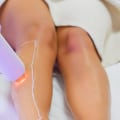Experience 70% to 90% permanent removal of unwanted hair using a laser technique in just six treatments and free yourself from the constant and endless cycle of shaving, waxing or waxing. We use multiple laser technologies to safely treat all skin types and hair textures. Although laser hair removal effectively delays hair growth for extended periods, it usually doesn't result in permanent hair removal. Several laser hair removal treatments are needed for initial hair removal, and maintenance treatments may also be needed.
Laser hair removal is most effective for people who have fair skin and dark hair, but it can be successfully used on all skin types. Most patients have permanent hair loss after an average of three to seven sessions. Laser hair removal involves the use of laser energy to damage the hair follicles in the treatment area. Once these follicles are damaged, they stop producing hair.
FDA has approved the use of lasers for “permanent hair reduction”. Because hair is in different phases of the growth cycle, laser hair removal at Advanced Laser and Skin Cancer Center generally permanently removes 85-90 percent of unwanted hair in treatment areas. The answer to this question isn't exactly. Many people confuse the idea of laser hair removal with the idea of never shaving again. FDA has approved the use of lasers for “permanent hair reduction”. Because hair is in different phases of the growth cycle, laser hair removal at Advanced Laser and Skin Cancer Center generally permanently removes 85-90 percent of unwanted hair in treatment areas. The answer to this question isn't exactly. Many people confuse the idea of laser hair removal with the idea of never shaving again.
However, these are two different things. In reality, laser hair removal is not actually “removing hair” at all. Instead, it provides long-lasting hair reduction by destroying hair follicles. While patients will never remove 100% of all hair follicles, the number of hair follicles that produce hair can be reduced by 75% to 90%.
Laser hair removal to treat the face is scheduled every 4 weeks, the bikini area and armpits (armpits) is usually scheduled every 4 to 6 weeks, while the arms and legs can be planned every 8 to 10 weeks. If you decide to use a home laser hair removal device, follow the instructions that come with the device to help reduce the risk of injury, especially eye injury. The next laser hair treatment is scheduled when new hair begins to emerge, during its growth phase. Previously, laser hair removal was only recommended for patients with light skin and dark hair, but with the advent of the GentleYag laser, Dr.
The amount of time for each laser hair removal treatment session depends on the thickness of the hair and the size of the surface area being treated. As with other areas of the body, several treatment sessions will be needed to remove unwanted hair. The treatment is a permanent solution for hair removal on many parts of the body, such as the face, back, arms, chest, bikini line and legs. Patients with white or gray hair cannot be treated with laser hair removal, as there is little melanin or pigmentation in the hair follicle.
The most common side effect after laser hair removal is some redness and possibly slight swelling in the treatment areas. There is a risk of skin burn, but that's usually just a problem with inexperienced operators who perform laser hair removal as a side activity. In these cases, patients need different methods of hair removal, such as electrolysis for permeant hair reduction. Laser hair removal is not recommended for eyelids, eyebrows, or surrounding areas, due to the possibility of serious eye damage.
Once several treatments have been performed to treat all hair follicles while they are in their growth phase, laser hair removal lasts forever. .









